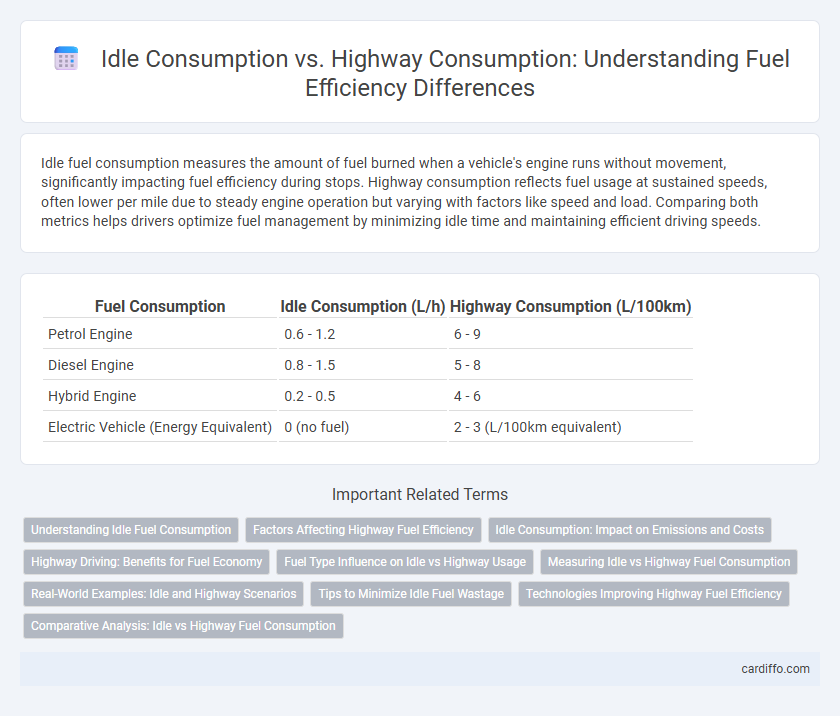Idle fuel consumption measures the amount of fuel burned when a vehicle's engine runs without movement, significantly impacting fuel efficiency during stops. Highway consumption reflects fuel usage at sustained speeds, often lower per mile due to steady engine operation but varying with factors like speed and load. Comparing both metrics helps drivers optimize fuel management by minimizing idle time and maintaining efficient driving speeds.
Table of Comparison
| Fuel Consumption | Idle Consumption (L/h) | Highway Consumption (L/100km) |
|---|---|---|
| Petrol Engine | 0.6 - 1.2 | 6 - 9 |
| Diesel Engine | 0.8 - 1.5 | 5 - 8 |
| Hybrid Engine | 0.2 - 0.5 | 4 - 6 |
| Electric Vehicle (Energy Equivalent) | 0 (no fuel) | 2 - 3 (L/100km equivalent) |
Understanding Idle Fuel Consumption
Idle fuel consumption refers to the amount of fuel a vehicle uses while the engine is running but the vehicle is stationary, often influenced by engine size, fuel type, and accessory load. This consumption can significantly impact overall fuel efficiency, especially in urban driving conditions with frequent stops. Monitoring idle fuel usage helps optimize fuel economy by reducing unnecessary idling time and encouraging practices such as turning off the engine during extended stops.
Factors Affecting Highway Fuel Efficiency
Highway fuel efficiency is influenced by factors such as vehicle speed, aerodynamic drag, tire pressure, and engine load, which collectively impact fuel consumption rates. Maintaining optimal tire pressure reduces rolling resistance, while smoother aerodynamic designs minimize drag at higher speeds, directly improving miles per gallon (MPG). Engine tuning and load variations, including additional cargo weight and the use of air conditioning, also play significant roles in determining highway fuel efficiency compared to idle consumption levels.
Idle Consumption: Impact on Emissions and Costs
Idle consumption significantly increases fuel waste and contributes to higher emissions of carbon dioxide and other pollutants, exacerbating environmental impact. Vehicles consume fuel at rates comparable to low-speed driving during idling, leading to unnecessary economic costs for drivers and businesses. Reducing idle time can dramatically cut fuel expenses and decrease greenhouse gas emissions, promoting both financial savings and environmental benefits.
Highway Driving: Benefits for Fuel Economy
Highway driving typically results in lower fuel consumption compared to idling due to consistent speeds and reduced engine load variability, improving miles per gallon (MPG). Maintaining steady speeds on highways minimizes fuel wastage caused by frequent acceleration and deceleration, optimizing engine efficiency. Vehicles operating at highway speeds often experience enhanced combustion processes, leading to better fuel economy and reduced emissions.
Fuel Type Influence on Idle vs Highway Usage
Diesel engines typically exhibit lower idle fuel consumption compared to gasoline engines due to higher energy density and more efficient combustion processes. At highway speeds, gasoline engines might achieve better fuel economy because of advanced fuel injection and turbocharging technologies that optimize fuel-air mixture. Variations in fuel type significantly influence the trade-off between idle and highway consumption, affecting overall efficiency based on engine design and operating conditions.
Measuring Idle vs Highway Fuel Consumption
Measuring idle fuel consumption involves tracking the fuel used by a vehicle when the engine runs but the vehicle remains stationary, typically recorded in gallons per hour or liters per hour. Highway fuel consumption is measured by calculating the fuel efficiency during steady-speed driving, usually expressed in miles per gallon (MPG) or liters per 100 kilometers (L/100 km). Accurate assessment requires precise tools such as flow meters for idle consumption and onboard diagnostic systems or controlled driving tests for highway consumption.
Real-World Examples: Idle and Highway Scenarios
Idle consumption often exceeds expectations, with engines burning 0.2 to 0.5 gallons of fuel per hour while stationary, leading to significant fuel waste during prolonged stops. In contrast, highway consumption averages around 25 to 35 miles per gallon, depending on vehicle type and driving conditions, making steady speeds more fuel-efficient. Real-world examples show city buses using nearly 50% more fuel idling at stops compared to cruising on highways, highlighting the impact of driving patterns on overall fuel economy.
Tips to Minimize Idle Fuel Wastage
Minimizing idle fuel wastage requires turning off the engine during extended stops, as excessive idling can consume up to one liter of fuel per hour depending on engine size. Using start-stop systems or manually switching off the engine reduces unnecessary fuel burn and emissions. Regular maintenance ensures efficient fuel delivery, lowering idle fuel consumption compared to highway driving, where fuel use is more consistent and optimized.
Technologies Improving Highway Fuel Efficiency
Highway fuel consumption is significantly reduced by technologies such as turbocharging, direct fuel injection, and advanced automatic transmissions that optimize engine performance at sustained speeds. Aerodynamic enhancements, low rolling resistance tires, and lightweight materials also contribute to lower fuel use during highway driving. Engine start-stop systems and adaptive cruise control further improve highway fuel efficiency by minimizing unnecessary fuel consumption.
Comparative Analysis: Idle vs Highway Fuel Consumption
Idle fuel consumption typically ranges from 0.2 to 0.5 gallons per hour depending on engine size and efficiency, whereas highway consumption is measured by miles per gallon (MPG), often averaging between 25 to 35 MPG for most vehicles. Comparative analysis reveals that idling, especially during extended stops, can lead to significant fuel waste relative to steady highway driving where engines operate more efficiently at constant speeds. Optimizing fuel usage involves minimizing idle time and maintaining consistent highway speeds to reduce overall fuel consumption and emissions.
Idle Consumption vs Highway Consumption Infographic

 cardiffo.com
cardiffo.com